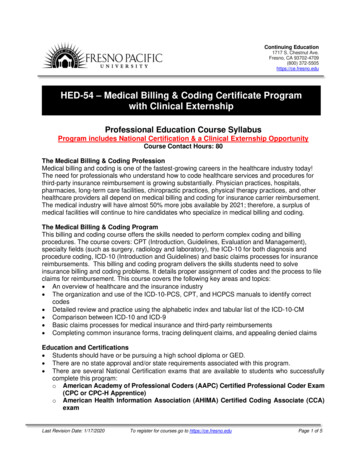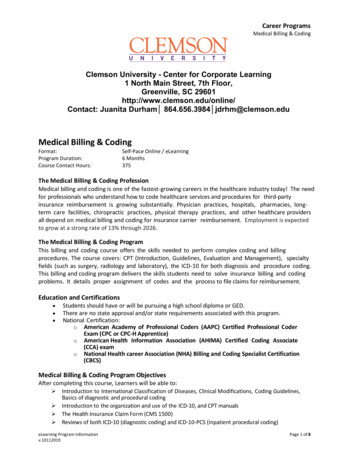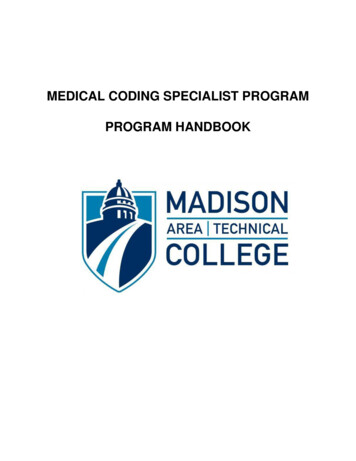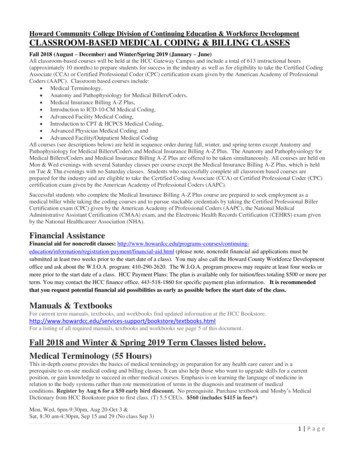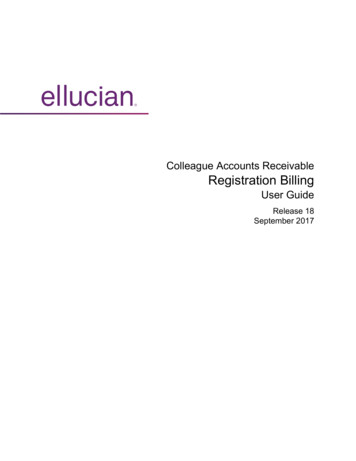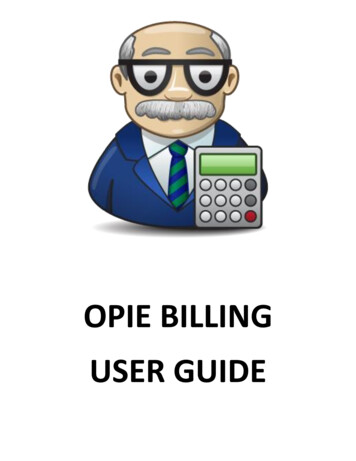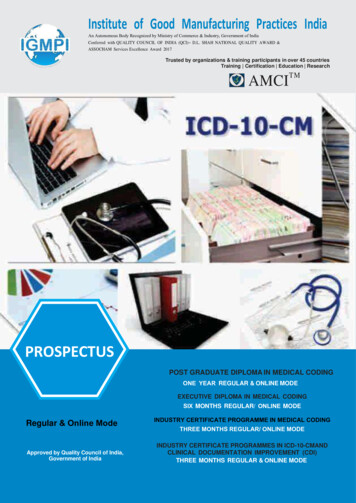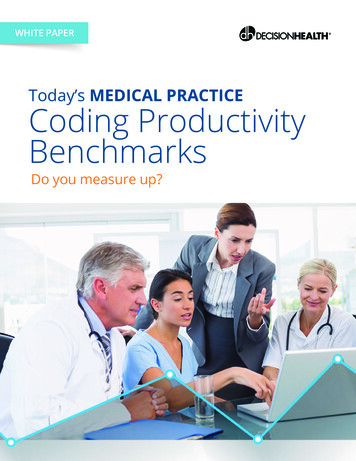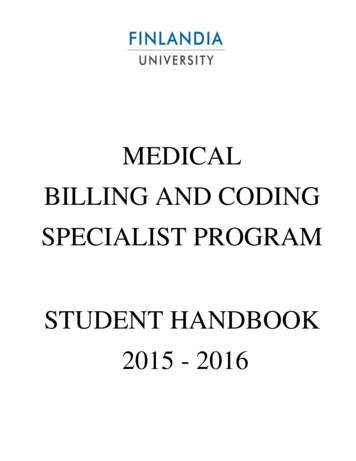
Transcription
MEDICALBILLING AND CODINGSPECIALIST PROGRAMSTUDENT HANDBOOK2015 - 2016
Finlandia UniversityAASMBC Student HandbookRevised: June 2015Page 2
Welcome to the College of Health Sciences Department and to the Medical Billing and Coding SpecialistProgram!Medical Billing and Coding is a very versatile health care career, which is forecast to be one of the fastestgrowing professions for the 21st century. As a professional medical billing and coding specialist you willhave the knowledge and understanding to analyze medical records and assign codes to classify diagnosesand procedures while applying the principles of professional and ethical conduct. The program willprepare the student for an entry-level position as a medical coder in a hospital, clinic, physician’s office orother healthcare facility.If we were asked to offer some advice to new students as they begin our program, we would provide thefollowing: Participate fully in all the experiences that you are offered. Have the ability to get along with and work well with others is a quality that employers are seeking. Be open to new ideas. Realize that you will probably have at least 2-3 hours of homework/study for each hour ofinstruction. Participate actively in your learning. Read this handbook carefully; it describes the program and departmental policies and procedures.Everyone at Finlandia University wants you to succeed. Developing technical skills is important, butgrowing personally, working effectively with others, and being an ethical, professional person is equallyimportant.Again, welcome! Do not hesitate to come in to see us or ask for help.Sincerely,The Finlandia University Medical Billing and Coding FacultyFinlandia UniversityAASMBC Student HandbookRevised: June 2015Page 3
Table of ContentsFINLANDIA UNIVERSITY MBC STUDENT .F.G.H.PROGRAM DESCRIPTIONMBC Program Faculty .MBC Program Description Program Goals .Outcomes .Level Competencies .Program of Study .Course Descriptions .6789101314STANDARDS FOR PROFESSIONAL PRACTICEAHIMA Code of Ethics .Student Code of Conduct .Academic Honesty, Cheating and Plagiarism .Writing Standards Certification .1724252526ADMISSION STANDARDSIntroduction to Admissions .Admission to the MBC Program Admission Decisions for High School Graduates Pre-Medical Billing and Coding Specialist .Progression Criteria Additional Requirements Mandatory Meetings Student Considerations Finlandia UniversityAASMBC Student HandbookRevised: June 20152727282828293030Page 4
SION STANDARDSGrading Policy. . .Academic Retention .Advising .Student Support Services .Retention Statement .Withdrawal from Program .Probation Dismissal Readmission .Appeals Process .Disciplinary Action Appeals .Social or Personal Appeals 313132333333333435353636MBC DEPARTMENT POLICIESAttendance Policy .Attendance at Externship .Exam/Quiz Policy .HIPAA and Confidentiality .Students Who Work For Compensation Transportation Use of Technology in the Classroom and Clinical Setting 37373838394040VERIFICATION FORM .41Finlandia UniversityAASMBC Student HandbookRevised: June 2015Page 5
FINLANDIA UNIVERSITYMBC PROGRAM FACULTYProgram Director and Practicum CoordinatorPamela Audette MBA, MT (ASCP), Michele Grisolono, CMA, AHA, nistrative AssistantAnne Halgren906-487-7308anne.halgren@finlandia.eduMBC Faculty and Staff are available to assist you.We welcome any questions, comments or suggestions you may have.Finlandia UniversityAASMBC Student HandbookRevised: June 2015Page 6
THE MEDICAL BILLING AND CODING DEPARTMENT IS LOCATED WITHINTHE COLLEGE OF HEALTH SCIENCESINTRODUCTION TO THEMEDICAL BILLING AND CODING (MBC) SPECIALISTSTUDENT HANDBOOKThe guidelines contained within this publication have been prepared by the medical billing and codingfaculty and is used in conjunction with the guidelines set forth by the University to inform students of thepolicies and the procedures that will guide you through your educational experience at Finlandia Universityand assist you with understanding the expectations within the medical billing and coding curriculum. It isthe student’s responsibility to read and understand the contents of the various University publications,including the MBC Student Handbook, Finlandia University Catalog and the Finlandia University StudentHandbook. Questions can be directed to any medical billing and coding faculty member.AASMBC PROGRAM DESCRIPTIONThe Medical Billing and Coding Specialist Associate Degree is a two-year, five-semester program,including one summer semester. Freshman-level students take such courses as college English, math,anatomy and physiology, medical terminology, and computer applications. Later, students will take coursesin medical office administrative procedures, EHRs, Insurance and Coding. One externship is also requiredfor the completion of the program. Upon graduation, a student will have completed 68 credits. Thiscurriculum provides the student with the opportunity for progression from the associate degree to abachelor’s degree in other disciplines such as health care administration, health sciences, nursing, nutrition,and health care law. Upon successful completion of the Medical Billing and Coding Specialist Program,graduates are eligible to apply for the Certified Coding Specialist (CCS) examination through the AmericanHealth Information Management Association (AHIMA).Finlandia UniversityAASMBC Student HandbookRevised: June 2015Page 7
Finlandia University Medical Billing and Coding Program GoalsThe goal of the Medical Billing and Coding Specialist (MBC) program is to provide the student with athorough understanding of the content of the medical record as well as extensive training in anatomy,physiology, the disease processes, and medical terminology. This program will provide the student with theknowledge and understanding to analyze medical records and assign codes to classify diagnoses andprocedures while applying the principles of professional and ethical conduct. The program will prepare thestudent for an entry-level position as a medical coder in a hospital, clinic, physician’s office, or otherhealthcare facility. An associate degree in medical billing and coding provides the basic knowledge, skills,and applied studies needed for entry-level positions in the healthcare field. The associate of applied sciencedegree program in Medical Billing and Coding provides students with educational opportunities in aquality learning environment, fostering competence, compassion, and dedication to the expectations oftheir chosen profession. The program integrates learning with the exploration of spirituality and ethics topromote intellectual and personal growth and development. Students actively participate in a competencybased curriculum, both within the classroom and through various clinical sites. Students engage in criticalthinking activities, demonstrate cognitive competencies, and develop professional behaviors.Finlandia UniversityAASMBC Student HandbookRevised: June 2015Page 8
Medical Billing and Coding Specialist Learning OutcomesThe Medical Billing and Coding Specialist curriculum provides the educational foundation for entry intothe field of medical coding within a healthcare organization. Educational experiences are organized withinthe framework of identified collegiate competencies. Curricular content increases in scope and complexityas the MBC student progresses towards successful completion of each of the core competencies requiredfor graduation from Finlandia University’s Medical Billing and Coding Specialist Program. The learningoutcomes are successfully completed through cognitive competencies demonstrating:1. Communication: The MBC graduate exhibits effective interpersonal written and oral communicationskills required for successful performance in the healthcare environment with the ability to read andunderstand medical documentation, diagnoses and procedures, and ensure that documentation supports thediagnosis and procedures performed.2. Analytical Skills: The MBC graduate applies knowledge of medical terminology, the disease process,anatomy and physiology, and pharmacology to analyze medical records and assign codes.3. Citizenship: The MBC graduate demonstrates personal and social responsibility for the safe andeffective delivery of healthcare services; integrates knowledge of ethical and legal responsibilities into theworkplace environment of healthcare organizations.4. Critical and Creative Thinking: The MBC graduate will think critically, write and speak effectively, usebasic computer applications, and understand human behavior in the context of the greater society.5. Cultural Heritage and Literacy: The MBC graduate demonstrates sensitivity to cultural, spiritual, andreligious influences when providing care to individuals in non-emergent healthcare environments.6. Concentration in Medical Billing and Coding: The MBC graduate possesses the necessary entry levelbilling and coding skills to practice as a medical billing and coding specialist in a variety of practicesettings.7. Concentration in Medical Billing and Coding: The MBC graduate is successful in qualifying forcertification/registration.Finlandia UniversityAASMBC Student HandbookRevised: June 2015Page 9
Medical Billing and Coding Student Learning OutcomesDomain I. Data Content Structure and StandardsDEFINITION: Academic content related to diagnostic and procedural classification and terminologies;health record documentation requirements; characteristics of the healthcare system; data accuracy andintegrity; data integration and interoperability; respond to customer data needs; data managementpolicies and procedures; information standards.Subdomain I.A Classification Systems1. Evaluate the accuracy of diagnostic and procedural coding.2. Manage diagnostic/procedural groupings3. Evaluate the accuracy of diagnostic/procedural groupings4. Consult reference materials to facilitate code assignmentSubdomain I.B. Health Record Content and Documentation1. Interpret health record documentation using knowledge of anatomy, physiology, clinical diseaseprocesses, pharmacology, and medical terminology to identify codeable diagnoses and/orprocedures.2. Analyze the documentation in the health record to ensure quality and completeness of coding.3. Determine when additional clinical documentation is needed to assign the diagnosis and/orprocedure code(s).4. Differentiate the roles and responsibilities of various providers and disciplines, to supportdocumentation requirements, throughout the continuum of healthcare.5. Engage with physicians and other healthcare providers to obtain further clinical documentation toassist with code assignment.6. Differentiate patient encounter type7. Determine and post charges for healthcare services based on documentation.8. Determine and resolve coding edits such as Correct Coding Initiative (CCI), Medicare Code Editor(MCE) and Outpatient Code Editor (OCE).Subdomain I.C. Data Governance1. Access the quality of coded data2. Determine the accuracy of abstracted data elements for data base integrity and claims processing.3. Facilitate healthcare providers’ education regarding reimbursement methodologies, documentationrules, and regulations related to coding.Domain II. Information Protection: Access Disclosure Archival Privacy and SecurityDefinition: Understand healthcare law (theory of all healthcare law to exclude application of lawcovered in Domain V); develop privacy, security, and confidentiality policies, procedures andinfrastructure; educate staff on health information protection methods; risk assessment; access anddisclosure management.Subdomain II.B. Data Privacy Confidentiality and Security1. Comply with policies and procedures for access and disclosure of personal health information.2. Determine/ report privacy issues/ problemsSubdomain III. H. Information integrity and Data Quality1. Ensure data integrity and validity using software of hardware technology reliability.Finlandia UniversityAASMBC Student HandbookRevised: June 2015Page 10
Domain V. ComplianceDefinition: COMPLIANCE activities and methods for all health information topics. For example, how tocomply with HIPAA, Stark Laws, Fraud and Abuse, etc.; coding auditing; severity of illness; dataanalytics; fraud surveillance; clinical documentation improvement.Subdomain V.A. Regulatory1. Analyze policies and procedures to ensure organizational compliance with regulations andstandards2. Collaborate with staff in preparing the organization for accreditation, licensure, and/or certification.Subdomain V.B. Coding1. Analyze current regulations and established guidelines in clinical classification systems2. Determine accuracy of computer assisted coding assignment and recommend corrective action3. Determine the diagnoses and procedures that require coding according to the current coding andreporting requirements for acute care (inpatient) and outpatient services.4. Interpret conventions, formats, instructional notations, tables, and definitions of the classificationsystem and/or nomenclature to select diagnoses, conditions, problems or other reasons for theencounter that require coding to include the procedures/services that require coding.5. Determine sequence of diagnoses and other reasons for encounter according to notations andconventions of the classification system and standard data set definitions (such as UniformHospital Discharge Data Set (UHDDS).6. Determine the sequence of procedures according to notations and conventions of the classificationsystem/nomenclature and standard data set definitions (such as UHDDS).7. Comply with the official classification systems coding guidelines (ICD9 and ICD10)8. Comply with the official CPT/HCPCS Level II coding guidelines.9. Take Part in the development of institutional coding policies to ensure compliance with officialcoding rules and guidelines.10. Evaluate the accuracy and completeness of the patient record as defined by organizational policyand external regulations and standards.11. Evaluate compliance with organization wide health record documentation and coding guidelines.12. Appraise/ report compliance concerns/findings.13. Determine the principal diagnosis, principal procedure, complications, comorbid conditions, otherdiagnoses and procedures that require coding according to UHDDS definitions and Coding Clinicfor the classification systems.14. Evaluate the impact of code selection on Diagnoses Related Group (DRG) assignment.15. Verify DRG assignment based on Inpatient Prospective Payment System (IPPS) definitions.16. Assign the appropriate discharge disposition.17. Determine the reason for encounter, pertinent secondary conditions, primary procedure, and otherprocedures that require coding according to UHDDS definitions, Official Coding Guidelines, CPTAssistant, Coding Clinic for classification systems, and HCPCS.18. Comply with Outpatient Prospective Payment System (OPPS) reporting requirements:a) Modifiersb) CPT/HCPCS Level IIc) Medical necessityd) Evaluation and Management code assignment (facility reporting).Finlandia UniversityAASMBC Student HandbookRevised: June 2015Page 11
Subdomain V.D. Clinical Documentation Improvement1. Examine discrepancies between supporting documentation and coded data2. Develop appropriate physician queries to resolve data and coding discrepancies3. Develop documentation improvement projects.4. Create a chain of command for resolving unanswered queries.5. Create consequences for non-compliance to queries or lack of responses to queries in collaborationwith providers6. Develop CDI policies and procedures in accordance with AHIMA practice briefs.Domain VI. LeadershipDefinition: Leadership models, theories, and skills; critical thinking; change management; workflowanalysis, design, tools and techniques; human resource management; training and development theoryand process; strategic planning; financial management; ethics and project and managementSubdomain: VI.A Leadership Roles1. Ensure affiliation with professional organizations devoted to the accuracy of diagnosis coding andreporting.2. Advocate CDI efforts throughout the organization3. Collaborate working relationship with CDI team members for reconciliation of queries4. Collaborate with physician champions to promote CDI initiativesSubdomain VI.E., Training and Development1. Facilitate healthcare providers’ education regarding reimbursement methodologies, documentationrules, and regulations related to coding.Subdomain VI.H. Ethics1. Comply with ethical standards of practice2. Evaluate the consequences of a breach of healthcare ethics3. Assess how cultural issues affect health, healthcare quality, cost, HIM4. Create programs and policies that support a culture of diversityFinlandia UniversityAASMBC Student HandbookRevised: June 2015Page 12
Program of StudyThe MBC program offers a unique two year program of study. Successful graduates will be awarded anAssociate of Applied Science Degree.Two Year ScheduleFIRST SEMESTER (fall)18 CREDITS*ENG 103College English I3*BIO 171Anatomy & Physiology I4*MATMAT 140 or above4*CIS 102Intro Computer Apps3COM 101Intro to Communication3**UNS 115Sisu Seminar1SECOND SEMESTER (spring)16 CREDITS*ENG 104College English II3BIO 172Anatomy & Physiology II4PSY 101Introductory Psychology3HSC 118Medical Term. for Health Care3REL/FNSReligion/ Finnish elective3THIRD SEMESTER (summer)8 CREDITSHSC 246Law & Ethics for HealthProfessionals2MAS 205MA Administrative Procedures4MAS 207Electronic Health Records2FOURTH SEMESTER (fall)13 CREDITSHSC 240Pharmacology for Allied Health2HSC 260Pathological Conditions2MAS 215Medical Insurance Billing3MBC 252Procedure Coding I3MBC 262Diagnosis Coding I3FIFTH SEMESTER (spring)13 CREDITSMBC 256Procedure Coding II3MBC 266Diagnosis Coding II3MBC 270Billing and Coding Externship4HCM 442Health Information Systems3*Must be successfully completed before taking courses at the 300-or400- level.**Required for students with less than 24 earned college-level credits.Finlandia UniversityAASMBC Student HandbookRevised: June 2015Page 13
AAS – Medical Billing and Coding Specialist Program Course DescriptionsNote: Numbers in parentheses denote credits assigned for theory (1st) and lab/clinical components (2nd).Contact hours for lab/clinical are calculated on a 3-hour per credit ratio.HSC118 Medical Terminology for Health Care (3-0)This course focuses on the component parts of medical terms: Prefixes, suffixes, combining forms, androot words. Students will learn, through a step-by-step word-building process, to understand and to beunderstood in the use of the language of medicine. Students practice formation, analysis andreconstruction of terms. Emphasis is placed on spelling, definition and pronunciation. This courseprovides an introduction to body systems, their operative, diagnostic, therapeutic and symptomaticterminology, as well as systemic and surgical terminology. Students study the application of these terms tomedical documentation, physical examinations, and medical diagnostic procedures. Mastery of medicalterminology is essential for successful administrative, clinical and laboratory interaction in the complexhealth care environment.HSC240 Pharmacology for Allied Health (2-0)This course introduces students to the classification of medications and basic pharmacological principles.Students apply these basic principles to the identification of common medications, medication preparation,and administration of medications and effects of medications on major body systems. (Prerequisites:BIO171, BIO172 and MAT140)HSC246 Law and Ethics for the Health Professions (2-0)This course engages the student in legal and ethical issues within the health care environment. The focuswill be on identifying complex legal and ethical issues, tort and criminal laws, and rules governing medicaland health care practices. Specific issues of professional legal and ethical conduct, laws governingconfidentiality, bioethics, medical records, reporting, end-of-life and beginning-of-life issues, legal andethical issues and the effects of managed care, and risk management procedures will be examined.(Prerequisite PHL 212)HSC260 Pathological Conditions (2-0)Major pathophysiological concepts will be studied from the cellular level to the resultant abnormalfunctioning of the organ systems. Topics include inflammation, immunity, neoplasia and allergy, as well asthe most commonly acquired and hereditary diseases. Disorders commonly encountered by practicingphysical therapist assistants will be particularly emphasized. Concepts from anatomy and physiologyprovide the foundation for exploring human dysfunction. (Prerequisite: BIO171, BIO172, PSY 101)Finlandia UniversityAASMBC Student HandbookRevised: June 2015Page 14
MAS205 Medical Assistant Administrative Procedures (3-1)This course introduces medical assistant students to office management and business administration.Students will learn to schedule appointments, file, manage records, perform telephone and reception dutiesand communicate effectively with patients, community members, and other health care and medical officestaff. Prerequisites: CIS102 or higher, BUS201, ENG 104, HSC118. Co-requisites: HSC 240, HSC 246,acceptance into the Medical Assisting Program.MAS207 Electronic Health Records Management (2)Introduction to the basics of medical records management. This course provides the opportunity to putadministrative skills learned in previous coursework into practice in a simulated medical setting usingelectronic health care records (EHR) and allows the student to learn about EHR management practices.Prerequisites: HSC 246, MAS 205MAS215 Introduction to Medical Insurance Billing (2-1)Introduction to medical office insurance billing procedures, patient financial records, computerized billing,collection procedures, and the identification and billing of various insurance plans including private,Medicare, Medicaid, TRICARE, Worker’s Compensation, HMO, group insurance plans, CHAMPUS, anddisability. Prerequisites: HSC 118, MAS 205MBC252 Procedure Coding I (3)Introduces the student to a coding system used by physician’s offices and outpatient facilities for codingoutpatient procedures. The course will include instruction on how to analyze, assign, and sequence codingprocedures in the CPT and HCPS coding systems. Fall semester. Prerequisite CIS102, HSC118 andMAS207.MBC256 Procedure Coding II (3)Introduces the student to a coding system used by hospitals for coding inpatient procedures. The coursewill include instruction on how to analyze, assign, and sequence coding procedures in the ICD-10-PCScoding system. Spring semesters. Prerequisite MCB252.MBC262 Diagnosis Coding I (3)Introduces the student to ICD-10-CM data set used for reporting diagnoses. This course will also includeinstruction on how to classify and index diagnoses in the healthcare setting. The various uses for diagnosiscodes will be discussed as well. Fall semesters. Prerequisite CIS 102, HSC 118 and MAS 207.Finlandia UniversityAASMBC Student HandbookRevised: June 2015Page 15
MBC266 Diagnosis Coding II (3)Further expands upon Diagnosis Coding I. The application of coding guidelines will continue to bereinforced. Spring semesters. Prerequisite MBC262.MBC270 Billing and Coding Externship (4)Prepares students for challenges in the workplace by improving their critical thinking and problem-solvingskills using case studies. Students will examine, analyze, develop and implement workplace solutions.During the externship phase of training, the student will experience various aspects of working in theinsurance billing and coding field. Spring semesters. Co-requisites MBC 256, MBC 266. Spring semesters.Finlandia UniversityAASMBC Student HandbookRevised: June 2015Page 16
MBC Program Statement of Conduct and Ethical StandardsThe student will abide by the American Health Information Management Association (AHIMA) Code ofEthics.The following ethical principles are based on the core values of the American Health InformationManagement Association and apply to all AHIMA members and certificants. Guidelines included for eachethical principle are a non-inclusive list of behaviors and situations that can help to clarify the principle.They are not meant to be a comprehensive list of all situations that can occur.I.Advocate, uphold, and defend the individual's right to privacy and the doctrine of confidentialityin the use and disclosure of information.A health information management professional shall:1.1. Safeguard all confidential patient information to include, but not limited to, personal,health, financial, genetic, and outcome information.1.2. Engage in social and political action that supports the protection of privacy andconfidentiality, and be aware of the impact of the political arena on the health informationissues for the healthcare industry.1.3. Advocate for changes in policy and legislation to ensure protection of privacy andconfidentiality, compliance, and other issues that surface as advocacy issues and facilitateinformed participation by the public on these issues.1.4. Protect the confidentiality of all information obtained in the course of professionalservice. Disclose only information that is directly relevant or necessary to achieve thepurpose of disclosure. Release information only with valid authorization from a patient or aperson legally authorized to consent on behalf of a patient or as authorized by federal or stateregulations. The minimum necessary standard is essential when releasing health informationfor disclosure activities.1.5. Promote the obligation to respect privacy by respecting confidential information sharedamong colleagues, while responding to requests from the legal profession, the media, or othernon-healthcare related individuals, during presentations or teaching and in situations thatcould cause harm to persons.1.6. Respond promptly and appropriately to patient requests to exercise their privacy rights(e.g., access, amendments, restriction, confidential communication, etc.). Answer truthfullyall patients’ questions concerning their rights to review and annotate their personalbiomedical data and seek to facilitate patients’ legitimate right to exercise those rights.Finlandia UniversityAASMBC Student HandbookRevised: June 2015Page 17
II.Put service and the health and welfare of persons before self-interest and conduct oneself in thepractice of the profession so as to bring honor to oneself, peers, and to the health informationmanagement profession.A health information management professional shall:2.1. Act with integrity, behave in a trustworthy manner, elevate service to others above selfinterest, and promote high standards of practice in every setting.2.2. Be aware of the profession's mission, values, and ethical principles, and practice in amanner consistent with them by acting honestly and responsibly.2.3. Anticipate, clarify, and avoid any conflict of interest, to all parties concerned, whendealing with consumers, consulting with competitors, in providing services requiringpotentially conflicting roles (for example, finding out information about one facility thatwould help a competitor), or serving the Association in a volunteer capacity. The conflictingroles or responsibilities must be clarified and appropriate action taken to minimize anyconflict of interest.2.4. Ensure that the working environment is consistent and encourages compliance with theAHIMA Code of Ethics, taking reasonable steps to eliminate any conditions in theirorganizations that violate, interfere with, or discourage compliance with the code.2.5. Take responsibility and credit, including authorship credit, only for work they actuallyperform or to which they contribute. Honestly acknowledge the work of and the contributionsmade by others verbally or written, such as in publication.A health information management professional shall not:2.6. Permit one’s private conduct to interfere with the ability to fulfill one’s professionalresponsibilities.2.7. Take unfair advantage of any professional relationship or exploit others to further one’sown personal, religious, political, or business interests.III.Preserve, protect, and secure personal health information in any form or medium and hold in thehighest regards health information and other information of a confidential nature obtained in anofficial capacity, taking into account the applicable statutes and regulations.A health information management professional shall:3.1. Safeguard the privacy and security of written and
Welcome to the College of Health Sciences Department and to the Medical Billing and Coding Specialist Program! Medical Billing and Coding is a very versatile health care career, which is forecast to be one of the fastest growing professions for the 21st century. As a professional medical billing and coding specialist you will
